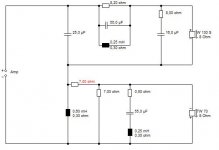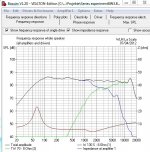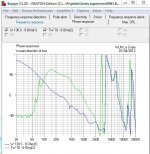Hi,
I posted in this thread ages ago that series first order is far better for
passive sub/sat x/o's than parallel first order (which doesn't work),
and BTW it doesn't need zobels on the drivers to work well, at all.
I've also described previously situations where the same sort
of issues come into play for simple series versus parallel.
Bass/mid xo's, FAST x/o's, mid /treble x/o's.
Technically its not complicated, driver interaction is different.
rgds, sreten.
A synopsis * : For simple first order electrical series is often better
than parallel unless electrical assymetry is needed (often is). Second
order electrical series is nearly always worse than parallel and usually
needs zobels. Third order electrical series is a rare beast, so is fourth.
What matters finally is the acoustic slopes, not the electrical function.
* For real drivers and real situations for the simplest x/o.
I posted in this thread ages ago that series first order is far better for
passive sub/sat x/o's than parallel first order (which doesn't work),
and BTW it doesn't need zobels on the drivers to work well, at all.
I've also described previously situations where the same sort
of issues come into play for simple series versus parallel.
Bass/mid xo's, FAST x/o's, mid /treble x/o's.
Technically its not complicated, driver interaction is different.
rgds, sreten.
A synopsis * : For simple first order electrical series is often better
than parallel unless electrical assymetry is needed (often is). Second
order electrical series is nearly always worse than parallel and usually
needs zobels. Third order electrical series is a rare beast, so is fourth.
What matters finally is the acoustic slopes, not the electrical function.
* For real drivers and real situations for the simplest x/o.
Last edited:
Right On
Well summarized. Couldn't agree more.
Hi,
A synopsis * : For simple first order electrical series is often better
than parallel unless electrical assymetry is needed (often is). Second
order electrical series is nearly always worse than parallel and usually
needs zobels. Third order electrical series is a rare beast, so is fourth.
What matters finally is the acoustic slopes, not the electrical function.
Well summarized. Couldn't agree more.
Allen B I look at the frequencies above the woofer voice coil inductance as being harsh. If you ever listened to a tweeter without a capacitor the lower frequencies sound harsh.
Frequencies where the the impedance rise are non linear. They are beyond the useable bandwitth of the driver due to it's cone diameter and voice coil inductance. I stated this in previous posts.
Listening to the flattened frequecnies with impedance equaliztion is just that electronically equalized frequencies. The equalization is unnatural,
Fried was against bi and tri amping. He always claimed the series crossover gave the listener the illusion of the full range sound. I for one agree.
You do not hear the driver separation sound like so many other speakers convey.
I would look at this as kind of defeating the whole point of the series crossover. If you have ever listened to a driver in it's enclosure without the L1 even with using a Zobel the higher frequencies sound ear fatiguing from a woofer. Why intoduce this sound to the final design.
Another reason to use the drivers voice coil inductance as the cutoff frequency for L1
I have read many crossover designs in Speaker Builder where the designer changed Woofer Qw in the crossover design. One L - R 12 db design where the L1 value on Seas P17RC driver was calculated to a value of .85mh. This was changed to a 1.2mh. It gave a flatter response. The Seas woofer voice coil mh is 1.1 mh according to many old catalogs. Just coincidence I think not.
Zobels are never used on the sub drivers which are true subwoofers.
The Zobel is not needed for the plan I sent you. It is used with the same midbass and tweeter in the 6.85 degree sloped front time aligned satellites.
It is food for thought when comparing the drivers being used in flat baffles compared to sloped baffles.
ThorstenL a rifled slug has 1700 feet per second velocity at muzzle then drops off rapidly. So the term slug is used in the name of the projectile.
It does give a lot of kick. Nothing like a anti tank weapon.
Frequencies where the the impedance rise are non linear. They are beyond the useable bandwitth of the driver due to it's cone diameter and voice coil inductance. I stated this in previous posts.
Listening to the flattened frequecnies with impedance equaliztion is just that electronically equalized frequencies. The equalization is unnatural,
Fried was against bi and tri amping. He always claimed the series crossover gave the listener the illusion of the full range sound. I for one agree.
You do not hear the driver separation sound like so many other speakers convey.
I would look at this as kind of defeating the whole point of the series crossover. If you have ever listened to a driver in it's enclosure without the L1 even with using a Zobel the higher frequencies sound ear fatiguing from a woofer. Why intoduce this sound to the final design.
Another reason to use the drivers voice coil inductance as the cutoff frequency for L1
I have read many crossover designs in Speaker Builder where the designer changed Woofer Qw in the crossover design. One L - R 12 db design where the L1 value on Seas P17RC driver was calculated to a value of .85mh. This was changed to a 1.2mh. It gave a flatter response. The Seas woofer voice coil mh is 1.1 mh according to many old catalogs. Just coincidence I think not.
Zobels are never used on the sub drivers which are true subwoofers.
The Zobel is not needed for the plan I sent you. It is used with the same midbass and tweeter in the 6.85 degree sloped front time aligned satellites.
It is food for thought when comparing the drivers being used in flat baffles compared to sloped baffles.
ThorstenL a rifled slug has 1700 feet per second velocity at muzzle then drops off rapidly. So the term slug is used in the name of the projectile.
It does give a lot of kick. Nothing like a anti tank weapon.
What Jack said is what I posted earlier. Sonus Faber, I have no idea which model, I read about it in Speakerasylum. A parallel series hybrid. It is patented.
It is impossible to remember all the various companies that come and go using series crossovers.
The Meadowlark company used the series and t-line like Fried. I heard them in the late 90's. They also had sloped front time alignment.
I think ThorstenL scared David posting about sniper rifles.
A Streamlight TLR-1 may not be able to handel the kick of the sniper rifle.
It has held up on my Remington 870 for its use in crop damage.
It is impossible to remember all the various companies that come and go using series crossovers.
The Meadowlark company used the series and t-line like Fried. I heard them in the late 90's. They also had sloped front time alignment.
I think ThorstenL scared David posting about sniper rifles.
A Streamlight TLR-1 may not be able to handel the kick of the sniper rifle.
It has held up on my Remington 870 for its use in crop damage.
A brick wall you say? How ironic that you would state it that way.
Head-bashing against brick walls can have the unintended consequence of discovering that the brick walls in question are actually self-imposed.
When faced with a specific example which clearly refuted your brashly worded postulate, you attempted to deny it by implying it is a useless example not used in "modern" design technique. Wrong again!
I hate to burst your bubble, but MANY very well-regarded engineers STILL use the series approach for both cost AND performance reasons in LF xo applications. And many of them also use parallel topologies. And in breaking news, this just in: some of us actually COMBINE series topologies in one section with parallel in the other.
Good Heavens! What kind of heresy is that???
And this can also apply for the upper mids to HF xo, but I don't see where spending another hour on illustrating this with another example is going to help you open your mind, so that'll be for another time.
When it becomes clear your position is not entirely accurate and is not garnering popular support, well then you retreat, all the while muttering about brick walls. Well, OK then. That's really smart.
What is this, a political forum, where we somehow believe the votes on the merits of topologies can somehow supersede a whole branch of well established circuit design and engineering practice? I hope not.
This debate shouldn't be about our viewpoint, keep it to the technical level and back it up with some actual knowledge instead of pompous proclamations.
But, of course, anyone here is always welcome to go play in their own private sandbox where private beliefs will go unchallenged even if they are partially or completely erroneous.
Happy trails on your path to discovery. Brick walls? Indeed !
You give ZERO examples of the "MANY" engineers using the example you gave and didn't even bother refuting why having a lowpass 1st order crossover at 150 Hz is a bad thing and instead "preach" about blah blah blah and attack my position when in FACT I was refering to the above silly posts about WW2 rifles and power cables
"This debate shouldn't be about our viewpoint, keep it to the technical level and back it up with some actual knowledge instead of pompous proclamations".....go look in the mirror.
This is just another example of someone typing a page of blather instead of stating any facts. I felt compelled to at least not let you get the "last word" since that is exactly the tone you intended. Have fun being so "correct" pal.

Done and Done
I've been following these discussions with much interest, just for the sake of learning about series crossover theory, drawbacks and positives. I find it very interesting.
I am, however, increasingly curious to know why the discussion seems to keep veering off into this mundane competition that always seems to contain the same verbage: "You forgot to post facts / links, so you're stupid and/or your comment is invalid" yet somehow, their own comment, with the same lack of technical information is somehow valid itself.
Can we keep this technical and informative using examples and real world experience? It's a lot more helpful and easier to read than pages upon pages of individuals trying to refute conjecture with anger and competing for who can find the most number of posts to trash, while only armed with hypocritical personal attacks.
Peace brothers, can't we all just get along?
I am, however, increasingly curious to know why the discussion seems to keep veering off into this mundane competition that always seems to contain the same verbage: "You forgot to post facts / links, so you're stupid and/or your comment is invalid" yet somehow, their own comment, with the same lack of technical information is somehow valid itself.
Can we keep this technical and informative using examples and real world experience? It's a lot more helpful and easier to read than pages upon pages of individuals trying to refute conjecture with anger and competing for who can find the most number of posts to trash, while only armed with hypocritical personal attacks.
Peace brothers, can't we all just get along?
Johnk and other are correct about the bashing. I am sick of it. Back when I got into this hobby many publications suggested a series crossover was far simpler using textbook values compared to the parallel. Back in 1980 driver specs were limited. Speaker Builder had debates with various authors. One tried a series crossover using 4 inductors with iron cores that came out awful.
I am told that I am living in the past. I occasionally listen to vinyl on my 30 year old Technics Sl-10. I like tube amps but they are not large enough in power for the deep bass in the t-lines. I am not going to spend tens of thousand of dollars on tube amps that could also be considered living in the past
.
Most people listen to music on their Ipods through a receiver.
I like tio share knowledge help others and also learn.
I have been told I am a audio snob. If someone owns a Krell amp are they an audio snob?
I am told that I am living in the past. I occasionally listen to vinyl on my 30 year old Technics Sl-10. I like tube amps but they are not large enough in power for the deep bass in the t-lines. I am not going to spend tens of thousand of dollars on tube amps that could also be considered living in the past
.
Most people listen to music on their Ipods through a receiver.
I like tio share knowledge help others and also learn.
I have been told I am a audio snob. If someone owns a Krell amp are they an audio snob?
It's Chevy vs Ford, Threshold vs Audio Research, Democrat vs Republican, Regan vs Gorbachev, yours vs mine. What do you expect, world peace?
+1
These days though, it's republican vs republican. Then again, all that will change in a few months.
Back when I got into this hobby many publications suggested a series
crossover was far simpler using textbook values compared to the parallel.
Hi,
That is certainly true. Series first order with textbook values will be
far less wrong than parallel first order due to bass/ mid inductance.
Thing is time has moved on. Things can be too simple.
Anyone who knows anything knows you shouldn't use
textbook values for 1st order parallel without a LP zobel.
Those that know a little also know first order electrical for a
mid to tweeter hardly ever give a 1st order acoustic response.
The combination of driver might suit a symmetrical electrical
x/o at the x/o point and 1st order series electrical might work.
However if an assymetrical electrical x/o is more suited, i.e.
different electrical x/o points for the LP and HP this is not
easily done with series and parallel is the way to go usually.
e.g. take this very budget ($2.50) tweeter :
An externally hosted image should be here but it was not working when we last tested it.
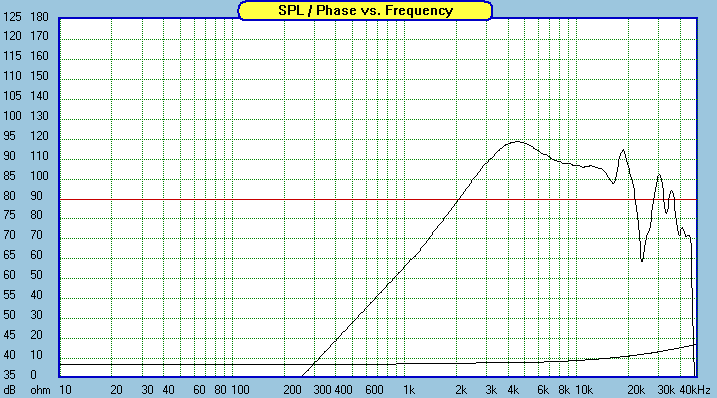
Above is the raw response, and below with a series 2.7uF capacitor
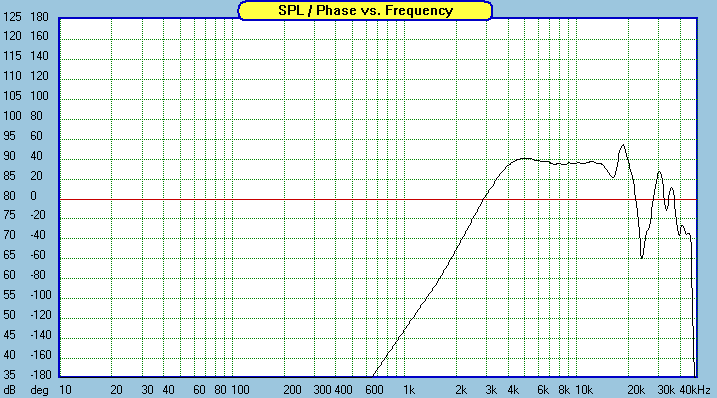
Classic third order acoustic roll off, around 3.5KHz.
The driver has clearly been designed to be used this way.
Electrically the x/o point is around 7KHz, series won't work here easily.
Series can work with a seriously overdamped x/o (i.e. double
the inductor value and half the capacitor value of Butterworth
@ 3.5KHz) only if the symmetry suits the mid unit as well, if it
doesn't - then parallel could still work well.
Point being whatever x/o you implement it won't be first order acoustic.
Don't point out I've chosen a totally inappropriate driver,
1st order electrical crossovers abound in cheap speakers,
and their design is just as interesting as expensive ones.
rgds, sreten.
rgds, sreten.
Last edited:
Hi,
There is another way. Add an RC equaliser (and necessary parallel resistor to get the impedance at crossover right) and use a series crossover. This is what I did for my tweeter:
I needed around 3dB L-Pad (luckily the tweeter is pure resistive) which in my case with tweeter being 4 ohm got me close to the 6 ohm needed for my overall speaker target impedance, a bypass cap on the L-Pad brings the high treble up a smidgen... So it is still a very simple crossover.
Your example needs more EQ, a direct consequence of the "constant directivity" design, but an L-Pad with bypassed series R should work fine...
BTW, I have some Car Audio Focal Tweeters and some nice boxes with a 4"Midbass I specified/designed and a very nice Softdome (which I find to measure well but to sound much less well that will be replaced by the Focal's). I think I'll try a series XO on that one as well.
The Mid-Woofer was originally specified/designed to run completely open (no EQ or Lowpass) so it will love a series XO and the rising response of the tweeter at the bottom of it's range can be EQ'ed...
My only problem is that this will be the office speaker and I'm itching to do a fully active design instead (need to try something there)...
Ciao T
e.g. take this very budget ($2.50) tweeter :
....
Classic third order acoustic roll off, around 3.5KHz.
The driver has clearly been designed to be used this way.
Electrically the x/o point is around 7KHz, series won't work here easily.
There is another way. Add an RC equaliser (and necessary parallel resistor to get the impedance at crossover right) and use a series crossover. This is what I did for my tweeter:
An externally hosted image should be here but it was not working when we last tested it.
I needed around 3dB L-Pad (luckily the tweeter is pure resistive) which in my case with tweeter being 4 ohm got me close to the 6 ohm needed for my overall speaker target impedance, a bypass cap on the L-Pad brings the high treble up a smidgen... So it is still a very simple crossover.
Your example needs more EQ, a direct consequence of the "constant directivity" design, but an L-Pad with bypassed series R should work fine...
BTW, I have some Car Audio Focal Tweeters and some nice boxes with a 4"Midbass I specified/designed and a very nice Softdome (which I find to measure well but to sound much less well that will be replaced by the Focal's). I think I'll try a series XO on that one as well.
The Mid-Woofer was originally specified/designed to run completely open (no EQ or Lowpass) so it will love a series XO and the rising response of the tweeter at the bottom of it's range can be EQ'ed...
My only problem is that this will be the office speaker and I'm itching to do a fully active design instead (need to try something there)...
Ciao T
There is another way...
Ciao T
Hi,
There nearly always is
rgds, sreten.
Hi,
The only "general" crossovers I know are Pro-Audio active ones which basically do not work without being preceeded by a 3rd octave or better EQ (thankfully modern all digital XO's come with ton's of EQ options build in).
In PA systems where I build most of the stuff and where changes where rare I used my own crossovers with swappable cards that contained EQ and XQ (plus some frequency dependent LF EQ limiters on bass and lower mid), so the PA was mostly flat with the 3rd octave EQ "flat".
Ciao T
There nearly always is. Why it is so difficult to generalise x/o's.
The only "general" crossovers I know are Pro-Audio active ones which basically do not work without being preceeded by a 3rd octave or better EQ (thankfully modern all digital XO's come with ton's of EQ options build in).
In PA systems where I build most of the stuff and where changes where rare I used my own crossovers with swappable cards that contained EQ and XQ (plus some frequency dependent LF EQ limiters on bass and lower mid), so the PA was mostly flat with the 3rd octave EQ "flat".
Ciao T
Knowing my much-envied ability to make the complex simple, my good friend AllenB asked me for an update on the state of the art with series crossovers. Here goes, Allen. 
First thing you gotta know is that although the circuits are simple enough to design, they only work properly with well behaved drive units. Woofers are best low inductance plastic polycones with no serious cone breakup and smooth rolloff. Tweeters should be soft dome ferrofluid. See you're not going to be able to fix faults.
Why and how of serial crossovers
Series crossovers are time-aligned by nature, so your cabinet should take that into account:
So let's look at a specific design, using a Morel CAW638 and a Morel Classic CAT298. The CAW is a rather fine vented 0.63mH polycone unit with a smooth response, albeit a little bit of a peak at 4.5kHz, but then falls away nicely.
http://www.eltim.eu/index.php?item=&action=page&group_id=20000175&lang=EN
Two Zobels and a Fs correction circuit for the tweeter, all of which keep impedance flat. See its also using the Morel CAW638 voicecoil inductance and Zobel capacitance as the crossover values. The woofer crosses over where IT wants to, not where YOU want it to.
Er, that's it really. When I finish my next two projects, I may have a go at this. Looks easy enough. Thanks to the Eltim site for the drawings and links.
First thing you gotta know is that although the circuits are simple enough to design, they only work properly with well behaved drive units. Woofers are best low inductance plastic polycones with no serious cone breakup and smooth rolloff. Tweeters should be soft dome ferrofluid. See you're not going to be able to fix faults.
An externally hosted image should be here but it was not working when we last tested it.
Why and how of serial crossovers
Series crossovers are time-aligned by nature, so your cabinet should take that into account:
An externally hosted image should be here but it was not working when we last tested it.
So let's look at a specific design, using a Morel CAW638 and a Morel Classic CAT298. The CAW is a rather fine vented 0.63mH polycone unit with a smooth response, albeit a little bit of a peak at 4.5kHz, but then falls away nicely.
An externally hosted image should be here but it was not working when we last tested it.
http://www.eltim.eu/index.php?item=&action=page&group_id=20000175&lang=EN
Two Zobels and a Fs correction circuit for the tweeter, all of which keep impedance flat. See its also using the Morel CAW638 voicecoil inductance and Zobel capacitance as the crossover values. The woofer crosses over where IT wants to, not where YOU want it to.
Er, that's it really. When I finish my next two projects, I may have a go at this. Looks easy enough. Thanks to the Eltim site for the drawings and links.
Last edited:
Why and how of serial crossovers
Hi, Is another thread, its pointless posting it here. Its not remotely definitive, rgds, sreten.
Hi, Is another thread, its pointless posting it here. Its not remotely definitive, rgds, sreten.
System 7's post seems on topic to me.
Ignoring the the rest, the graphs alone prove quite interesting, and give something that is testable in the field and if shown to be an accurate conclusion something you can design for to reduce tweaking time.
dave
Why and how of serial crossovers
Ignoring the the rest, the graphs alone prove quite interesting, and give something that is testable in the field and if shown to be an accurate conclusion something you can design for to reduce tweaking time.
dave
Right on both counts, speakerman19422. This fine Morel SCW636 Carbon Fibre cone has exemplary extended frequency response and ultralow inductance at 0.29mH.Composite fiber cones do work well in series crossovers. I stated earlier peaky Kevlar not a good choice. Low inductance midbass drivers are the best. You can fix some faults with RC contour network in series with the tweeter.
Morel Supreme SCW636
I did find I could include a useful 1400Hz bass trap with the 5" paper 0.6mH W130S in combination with the interesting Visaton TW70 paper cone tweeter without messing anything up. Results here are not far different from what I could do with a 2nd. order parallel filter, but time alignment worked far better with the series network. I'd reckon this would be a good sounding setup, and the Fs filter transforms the TW70 from a BADLY BEHAVED HORROR into something that works well with series.
Attachments
Right on both counts, speakerman19422. This fine Morel SCW636 Carbon Fibre cone has exemplary extended frequency response and ultralow inductance at 0.29mH.
Morel Supreme SCW636
I did find I could include a useful 1400Hz bass trap with the 5" paper 0.6mH W130S in combination with the interesting Visaton TW70 paper cone tweeter without messing anything up. Results here are not far different from what I could do with a 2nd. order parallel filter, but time alignment worked far better with the series network. I'd reckon this would be a good sounding setup, and the Fs filter transforms the TW70 from a BADLY BEHAVED HORROR into something that works well with series.
Have you given us a glimpse of the future? Your sims have a date of July 4, 2012!
Right speaker? WLM LaScalas?
- Status
- This old topic is closed. If you want to reopen this topic, contact a moderator using the "Report Post" button.
- Home
- Loudspeakers
- Multi-Way
- Sreten & Speakerman go at series XOs
